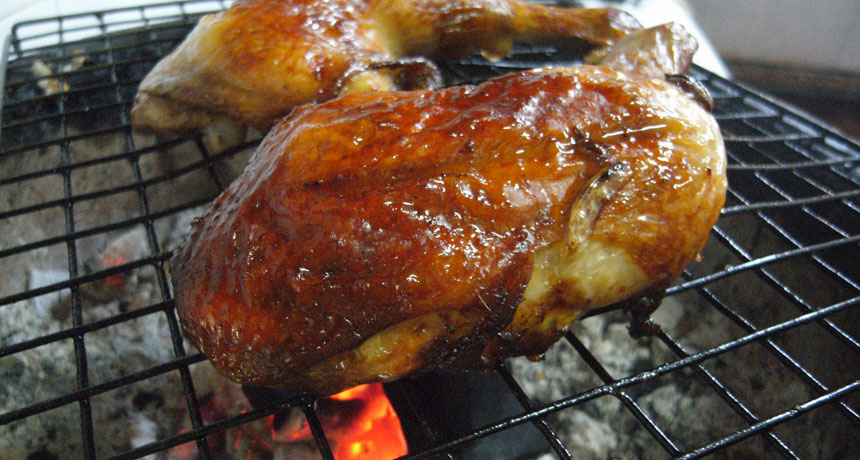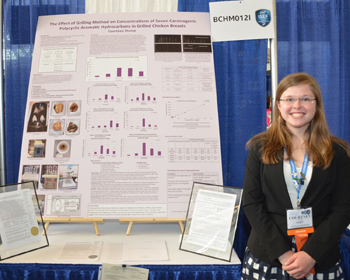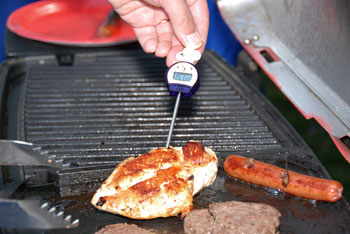Taking chicken off the grill and into the lab
A summer cookout can inspire a scientific project

When grilling chicken this summer, stick with a plain grill, a teen’s experiment shows.
Vee Satayamas/Flickr/(CC-BY-2.0)
PITTSBURGH, Pa. — Most summer cookouts probably don’t lead to a science project. But for Courtney Stump, 17, a little grilled chicken turned into a lot of time in the lab.
“I was at a friend’s house in Montana over the summer,” recalls the teen, a rising senior at Columbia River High School in Vancouver, Wash. “I was grilling chicken for about 20 people, and I remembered my freshman-year biology teacher told me whenever we grill or char things there are carcinogens that get created.”
Carcinogens are agents that cause cancer. Courtney decided to find out whether carcinogens were in her grilled chicken. She spent months in a lab, grilling chicken, grinding up chicken and studying chicken. She was hunting for polycyclic aromatic hydrocarbons, or PAHs. These chemicals are made when any fuel — including coal, oil and even chicken — is burned. Many PAHs can cause cancer. Charring or smoking chicken and other meats can create these chemicals. After a lot of research — and even more chicken — the teen found to avoid PAHs, ditch the specialty grill mats and smoker barbecues. Instead, stick with a clean, plain grill.

A good research project begins by hunting through scientific papers. The purpose is to see what other scientists have already accomplished. As Courtney read about grilling and carcinogens, she quickly realized that hunting for PAHs was going to be complex. “I didn’t have the kind of equipment at my house to do this kind of analysis,” she says. So once the teen created a research plan, she started calling around to universities in her area. Her goal: find a scientist who would let her into the lab to complete her study.
She ended up working with Steve Sylvester at the University of Washington at Vancouver. This scientist identifies molecules in the environment that might affect how plants and animals breed. Sylvester doesn’t usually study grilled chicken. But he did have a machine that Courtney could use — a gas chromatograph. This is a device that separates out the chemicals in a mixture of flowing gases. That allows scientists to identify how much of each chemical is present. This machine was attached to another, called a mass spectrometer. This second device determines exactly which chemicals make up the mixture. With these two scientific instruments, Courtney could determine what PAHs, and in what quantities, were in her chicken.

Courtney then ground up each sample into a liquid. She ran the liquids through the chromatograph and mass spectrometer. Courtney was hunting for 14 different PAHs. She found the chemicals on a list of carcinogens prepared by the European Union. After repeated experiments, the teen decided to stick with chicken breasts over thighs. “The chicken breasts gave me the most consistent numbers,” she explains.
After more than 20 chickens and many months in the lab, Courtney found that cooking chicken in a smoker barbecue creates the most PAHs. Meanwhile, chicken cooked on a plain grill produces the least. Of course, there were even fewer PAHs in the raw chicken. Since it’s best to eat chicken cooked, the teen concluded the plain grill is probably the best bet.
Her first experiment may be over, but Courtney has more in mind. She wants to look for other kinds of carcinogens in chicken. Unfortunately, her experiments have turned her off what used to be her favorite meat. And it’s not because she’s worried about getting sick. “Once you’ve taken chicken from a solid and ground it up into a liquid that many times, you’ve smelled and worked with it for months,” she explains. “I just don’t feel like eating that much chicken anymore.”
Follow Eureka! Lab on Twitter
Power Words
(for more about Power Words, click here)
biology The study of living things. The scientists who study them are known as biologists.
breed (noun) Animals within the same species that are so genetically similar that they produce reliable and characteristic traits. German shepherds and dachshunds, for instance, are examples of dog breeds. (verb) To produce offspring through reproduction.
cancer Any of more than 100 different diseases, each characterized by the rapid, uncontrolled growth of abnormal cells. The development and growth of cancers, also known as malignancies, can lead to tumors, pain and death.
carcinogen A substance, compound or other agent (such as radiation) that causes cancer.
chemical A substance formed from two or more atoms that unite (become bonded together) in a fixed proportion and structure. For example, water is a chemical made of two hydrogen atoms bonded to one oxygen atom. Its chemical symbol is H2O.
chromatography Separation and detection of chemical compounds as a result of their having traveled at different rates according to their different attractions to the matter that carries them (such as a flowing liquid or gas).
control A part of an experiment where there is no change from normal conditions. The control is essential to scientific experiments. It shows that any new effect is likely due only to the part of the test that a researcher has altered. For example, if scientists were testing different types of fertilizer in a garden, they would want one section of it to remain unfertilized, as the control. Its area would show how plants in this garden grow under normal conditions. And that give scientists something against which they can compare their experimental data.
environment The sum of all of the things that exist around some organism or process and the conditions they create for that organism or process. Environment may refer to the weather and ecosystem in which some animal lives, or, perhaps, the temperature, humidity and placement of components in some electronics system or product.
mass spectrometry A technique used to determine the chemical makeup of a source material.
molecule An electrically neutral group of atoms that represents the smallest possible amount of a chemical compound. Molecules can be made of single types of atoms or of different types. For example, the oxygen in the air is made of two oxygen atoms (O2), but water is made of two hydrogen atoms and one oxygen atom (H2O).
PAHs See polycyclic aromatic hydrocarbons
polycyclic aromatic hydrocarbons (or PAHs) A family of hydrocarbons. Many form naturally as part of crude oil. Some are formed when materials burn incompletely. Most PAHs occur in groups of two or more. Many of these compounds are quite toxic.
Society for Science & the Public (or SSP) A nonprofit organization created in 1921 and based in Washington, D.C. Since its founding, SSP has been not only promoting public engagement in scientific research but also the public understanding of science. It created and continues to run three renowned science competitions, including the Intel International Science and Engineering Fair (initially launched in 1950). SSP also publishes award-winning journalism in Science News (launched in 1922) and Science News for Students (created in 2003).
spectrometer An instrument used by chemists to measure and report the wavelengths of light that it observes. The collection of data using this instrument, a process is known as spectrometry, can help identify the elements or molecules present in an unknown sample.







